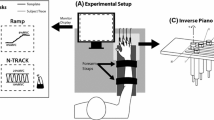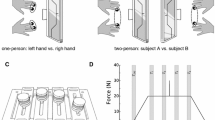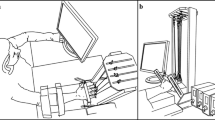Abstract
We analysed the effects of task symmetry during bilateral accurate force production tasks performed by the two feet. In particular, we tested a hypothesis that bilateral deficit would lead to higher indices of synergies defined as co-varied adjustments in the two forces across trials that reduced total force variability. The subjects produced steady-state force followed by a quick force pulse into the target. The two feet could be acting both into plantar flexion and into dorsiflexion (symmetrical tasks), or in opposite directions (asymmetrical task). We used the framework of the uncontrolled manifold hypothesis to quantify two variance components, one of which did not change total force (V UCM), while the other did (V ORT). Synergy indices during the asymmetrical task were higher than in either symmetrical task. The difference was due to higher V UCM (compared to the symmetrical plantar flexion task) or lower V ORT (compared to the symmetrical dorsiflexion task). The synergy index showed a drop (anticipatory synergy adjustment, ASA) starting 100–150 ms prior to the force pulse initiation. The ASA tended to be shorter and of a smaller magnitude for the asymmetrical task. This is the first demonstration of bilateral synergies during accurate force production by the legs. We conclude that bilateral deficit has no or weak effects on two-leg synergies. The results fit the earlier introduced scheme with two groups of neural variables defining average performance of a redundant system and patterns of co-variation among its elemental variables, respectively.




Similar content being viewed by others
Abbreviations
- ASA:
-
Anticipatory synergy adjustment
- DF-DF:
-
Bilateral dorsal flexion
- (dF TOT/dt)MAX :
-
Time of the maximal rate of F TOT development
- F L :
-
Force of the left leg
- F MAX :
-
Peak force of the pulse
- F R :
-
Force of the right leg
- F TOT :
-
Total force
- MVC:
-
Maximal voluntary contraction
- PF-DF:
-
Plantar flexion at the non-dominant side and dorsal flexion at the dominant side
- PF-PF:
-
Bilateral plantar flexion
- R :
-
Pearson’s correlation coefficient
- R Z :
-
z-Transformed Pearson’s correlation coefficient
- SS:
-
Steady state
- t 0 :
-
Start of the F TOT increase
- t ASA :
-
Time of ASA initiation
- UCM:
-
Uncontrolled manifold
- V ORT :
-
Variability destabilizing the performance variable, “bad variability”
- VUCM :
-
Variability stabilizing the performance variable, “good variability”
- ΔV :
-
Index of a synergy
- ΔV Z :
-
z-Transformed index of synergy
- ΔΔV :
-
Amplitude of ASA
- ΔΔV Z :
-
z-Transformed amplitude of ASA
References
Archontides C, Fazey JA (1993) Inter-limb interactions and constraints in the expression of maximum force: a review, some implications and suggested underlying mechanisms. J Sports Sci 11:145–158. doi:10.1080/02640419308729978
Auyang AG, Yen JT, Chang YH (2009) Neuromechanical stabilization of leg length and orientation through interjoint compensation during human hopping. Exp Brain Res 192:253–264. doi:10.1007/s00221-008-1582-7
Bernstein NA (1967) The co-ordination and regulation of movements. Pergamon Press, Oxford
Domkin D, Laczko J, Jaric S, Johansson H, Latash ML (2002) Structure of joint variability in bimanual pointing tasks. Exp Brain Res 143:11–23. doi:10.1007/s00221-001-0944-1
Domkin D, Laczko J, Djupsjobacka M, Jaric S, Latash ML (2005) Joint angle variability in 3D bimanual pointing: uncontrolled manifold analysis. Exp Brain Res 163:44–57. doi:10.1007/s00221-004-2137-1
Freitas SM, Scholz JP (2009) Does hand dominance affect the use of motor abundance when reaching to uncertain targets? Hum Mov Sci 28:169–190. doi:10.1016/j.humov.2009.01.003
Freitas SM, Duarte M, Latash ML (2006) Two kinematic synergies in voluntary whole-body movements during standing. J Neurophysiol 95:636–645. doi:10.1152/jn.00482.2005
Freitas SM, Scholz JP, Stehman AJ (2007) Effect of motor planning on use of motor abundance. Neurosci Lett 417:66–71. doi:10.1016/j.neulet.2007.02.037
Gelfand IM, Latash ML (1998) On the problem of adequate language in motor control. Mot Control 2:306–313
Goodman SR, Shim JK, Zatsiorsky VM, Latash ML (2005) Motor variability within a multi-effector system: experimental and analytical studies of multi-finger production of quick force pulses. Exp Brain Res 163:75–85. doi:10.1007/s00221-004-2147-z
Gorniak SL, Zatsiorsky VM, Latash ML (2007a) Emerging and disappearing synergies in a hierarchically controlled system. Exp Brain Res 183:259–270. doi:10.1007/s00221-007-1042-9
Gorniak SL, Zatsiorsky VM, Latash ML (2007b) Hierarchies of synergies: an example of two-hand, multi-finger tasks. Exp Brain Res 179:167–180. doi:10.1007/s00221-006-0777-z
Hayes HB, Chang YH, Hochman S (2012) Stance-phase force on the opposite limb dictates swing-phase afferent presynaptic inhibition during locomotion. J Neurophysiol 107:3168–3180. doi:10.1152/jn.01134.2011
Howard JD, Enoka RM (1991) Maximum bilateral contractions are modified by neurally mediated interlimb effects. J Appl Physiol 70:306–316
Hu X, Newell KM (2011) Visual information gain and task asymmetry interact in bimanual force coordination and control. Exp Brain Res 212:497–504. doi:10.1007/s00221-011-2760-6
Jakobi JM, Chilibeck PD (2001) Bilateral and unilateral contractions: possible differences in maximal voluntary force. Can J Appl Physiol 26:12–33
Kang N, Shinohara M, Zatsiorsky VM, Latash ML (2004) Learning multi-finger synergies: an uncontrolled manifold analysis. Exp Brain Res 157:336–350. doi:10.1007/s00221-004-1850-0
Kawakami Y, Sale DG, MacDougall JD, Moroz JS (1998) Bilateral deficit in plantar flexion: relation to knee joint position, muscle activation, and reflex excitability. Eur J Appl Physiol Occup Physiol 77:212–216
Klous M, Mikulic P, Latash ML (2011) Two aspects of feedforward postural control: anticipatory postural adjustments and anticipatory synergy adjustments. J Neurophysiol 105:2275–2288. doi:10.1152/jn.00665.2010
Krishnan V, Aruin AS, Latash ML (2011) Two stages and three components of the postural preparation to action. Exp Brain Res 212:47–63. doi:10.1007/s00221-011-2694-z
Krishnan V, Latash ML, Aruin AS (2012) Early and late components of feed-forward postural adjustments to predictable perturbations. Clin Neurophysiol 123:1016–1026. doi:10.1016/j.clinph.2011.09.014
Latash ML (2008) Synergy. Oxford University Press, USA
Latash ML (2010) Motor synergies and the equilibrium-point hypothesis. Mot Control 14:294–322
Latash ML (2012) The bliss (not the problem) of motor abundance (not redundancy). Exp Brain Res 217:1–5. doi:10.1007/s00221-012-3000-4
Latash ML, Scholz JF, Danion F, Schoner G (2002a) Finger coordination during discrete and oscillatory force production tasks. Exp Brain Res 146:419–432. doi:10.1007/s00221-002-1196-4
Latash ML, Scholz JP, Schoner G (2002b) Motor control strategies revealed in the structure of motor variability. Exerc Sport Sci Rev 30:26–31
Latash ML, Yarrow K, Rothwell JC (2003) Changes in finger coordination and responses to single pulse TMS of motor cortex during practice of a multifinger force production task. Exp Brain Res 151:60–71. doi:10.1007/s00221-003-1480-y
Latash ML, Shim JK, Smilga AV, Zatsiorsky VM (2005) A central back-coupling hypothesis on the organization of motor synergies: a physical metaphor and a neural model. Biol Cybern 92:186–191. doi:10.1007/s00422-005-0548-0
Latash ML, Scholz JP, Schoner G (2007) Toward a new theory of motor synergies. Mot Control 11:276–308
Li S, Danion F, Latash ML, Li ZM, Zatsiorsky VM (2001) Bilateral deficit and symmetry in finger force production during two-hand multifinger tasks. Exp Brain Res 141:530–540. doi:10.1007/s002210100893
Olafsdottir H, Yoshida N, Zatsiorsky VM, Latash ML (2005) Anticipatory covariation of finger forces during self-paced and reaction time force production. Neurosci Lett 381:92–96. doi:10.1016/j.neulet.2005.02.003
Park J, Wu Y-H, Lewis MM, Huang X, Latash ML (2012) Changes in multi-finger interaction and coordination in Parkinson’s disease. J Neurophysiol 108:915–924. doi:10.1016/j.clinph.2012.10.021
Park J, Lewis MM, Huang X, Latash ML (2013) Effects of olivo-ponto-cerebellar atrophy (OPCA) on finger interaction and coordination. Clin Neurophysiol (in press)
Scholz JP, Schoner G (1999) The uncontrolled manifold concept: identifying control variables for a functional task. Exp Brain Res 126:289–306
Scholz JP, Kang N, Patterson D, Latash ML (2003) Uncontrolled manifold analysis of single trials during multi-finger force production by persons with and without Down syndrome. Exp Brain Res 153:45–58. doi:10.1007/s00221-003-1580-8
Shim JK, Olafsdottir H, Zatsiorsky VM, Latash ML (2005) The emergence and disappearance of multi-digit synergies during force-production tasks. Exp Brain Res 164:260–270. doi:10.1007/s00221-005-2248-3
Shim JK, Park J, Zatsiorsky VM, Latash ML (2006) Adjustments of prehension synergies in response to self-triggered and experimenter-triggered load and torque perturbations. Exp Brain Res 175:641–653. doi:10.1007/s00221-006-0583-7
Skm V, Zatsiorsky VM, Latash ML (2010) Variance components in discrete force production tasks. Exp Brain Res 205:335–349. doi:10.1007/s00221-010-2367-3
Wu YH, Pazin N, Zatsiorsky VM, Latash ML (2012) Practicing elements versus practicing coordination: changes in the structure of variance. J Mot Behav 44:471–478. doi:10.1080/00222895.2012.740101
Yen JT, Chang YH (2010) Rate-dependent control strategies stabilize limb forces during human locomotion. J R Soc Interface 7:801–810. doi:10.1098/rsif.2009.0296
Zhou T, Wu Y-H, Bartsch A, Cuadra C, Zatsiorsky VM, Latash ML (2013) Anticipatory synergy adjustments: preparing a quick action in an unknown direction. Exp Brain Res (in press)
Acknowledgments
Nejc Sarabon would like to acknowledge the support of the Slovenian Research Agency, Grant No. L5—4293.
Author information
Authors and Affiliations
Corresponding author
Rights and permissions
About this article
Cite this article
Sarabon, N., Markovic, G., Mikulic, P. et al. Bilateral synergies in foot force production tasks. Exp Brain Res 227, 121–130 (2013). https://doi.org/10.1007/s00221-013-3494-4
Received:
Accepted:
Published:
Issue Date:
DOI: https://doi.org/10.1007/s00221-013-3494-4




